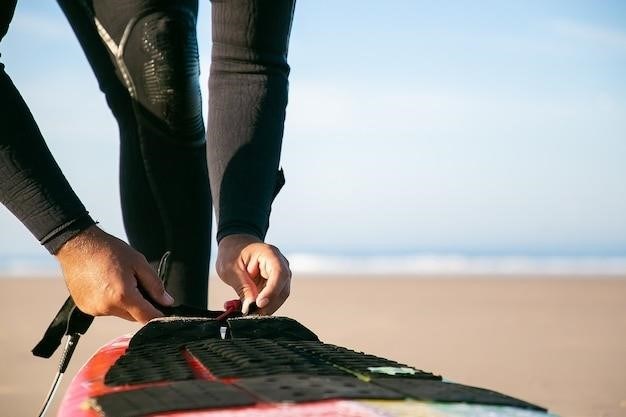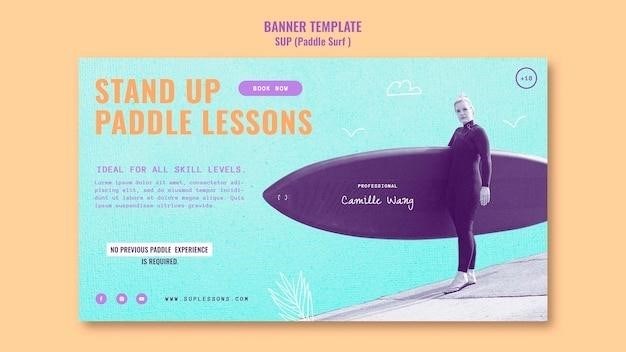SUP Board Size Guide⁚ Finding the Perfect Fit
Choosing the right stand up paddle board can be challenging‚ especially if you’re new to the sport. A SUP with the correct buoyancy‚ volume‚ and capacity will increase the longevity and enjoyment of your board. We’ve broken down all the characteristics of our paddle boards in the SUP Size…
Introduction⁚ Why Size Matters
The size of your SUP board plays a crucial role in your paddling experience. It directly affects your stability‚ speed‚ maneuverability‚ and overall performance. A board that is too small might feel unstable and difficult to paddle‚ while one that is too large can be cumbersome and slow. Choosing the right size ensures you can enjoy the sport comfortably and effectively‚ whether you’re cruising‚ surfing‚ or doing yoga on the water.
Factors Influencing SUP Board Size
Several factors come into play when determining the ideal SUP board size for you. These include your weight‚ height‚ experience level‚ and the type of paddling you plan to do. For instance‚ heavier individuals generally need larger boards for adequate buoyancy‚ while taller paddlers might prefer longer boards for better glide. Your experience level also impacts your choice‚ as beginners often opt for wider and longer boards for greater stability. Finally‚ consider the intended use of your board‚ as different activities like touring‚ surfing‚ or yoga require specific dimensions for optimal performance.
Weight
Your weight is a crucial factor in determining the appropriate SUP board size. Heavier individuals require boards with greater volume and weight capacity to ensure adequate buoyancy and stability. A board that’s too small for your weight will struggle to support you‚ making paddling difficult and potentially dangerous. Conversely‚ a board that’s too large might feel sluggish and less maneuverable. The ideal size will provide a balance between stability and performance‚ allowing you to enjoy your paddling experience without compromising safety.
Height
While weight plays a more significant role in choosing the right SUP board size‚ height can also be a factor. Taller individuals may find longer boards more comfortable‚ as they provide greater surface area for paddling and stability. Shorter riders‚ on the other hand‚ might prefer shorter boards that are easier to maneuver. However‚ it’s essential to remember that these are general guidelines‚ and the ideal board size ultimately depends on your individual needs and preferences.
Experience Level
Your experience level in stand-up paddleboarding will significantly influence your board size choice. Beginners will typically benefit from wider‚ longer boards that offer greater stability and forgiveness. As you gain experience and confidence‚ you can transition to shorter‚ narrower boards that provide more maneuverability and speed. Remember‚ choosing a board that suits your current skill level will enhance your enjoyment and learning process.
Intended Use
The intended use of your SUP board is a crucial factor in determining the ideal size. If you plan on leisurely paddling on calm waters‚ a longer‚ wider board will provide ample stability. For surfing‚ a shorter‚ narrower board will offer agility and maneuverability. Yoga enthusiasts will favor boards with a wider deck for balance and stability‚ while touring and racing boards require length and streamlined shapes for speed and efficiency.
Types of SUP Boards and Their Ideal Sizes
Different types of SUP boards cater to specific activities and skill levels. All-round SUP boards‚ typically 10-11 feet long‚ are versatile for beginners and casual paddling. SUP surfing boards‚ generally shorter and narrower‚ are designed for catching waves. Yoga SUP boards offer a wider deck for stability during practice‚ while touring SUP boards‚ often longer and narrower‚ are ideal for longer distances. Racing SUP boards are built for speed and efficiency‚ with streamlined shapes and lengths.
All-Round SUP Boards
All-round SUP boards are the most popular type due to their versatility. They are great for beginners‚ casual paddlers‚ and those who want a board that can handle a variety of activities. All-round SUP boards are typically 10-11 feet long and 30-34 inches wide‚ providing a good balance of stability and maneuverability. They are also relatively lightweight and easy to transport.
SUP Surfing Boards
SUP surfing boards are designed for catching waves and performing maneuvers. They are typically shorter and narrower than all-round boards‚ making them more maneuverable in the surf. They also have a pointed nose and a thinner profile‚ which helps them glide through the water more easily. SUP surfing boards are typically 8-10 feet long and 28-32 inches wide‚ with a volume of 150-200 liters.
Yoga SUP Boards
Yoga SUP boards are designed for practicing yoga on the water. They are typically wider and more stable than other types of SUP boards‚ providing a larger platform for balancing and performing poses. Yoga SUP boards also have a non-slip deck pad‚ which provides a comfortable and secure surface for practicing yoga. They are typically 10-12 feet long and 32-36 inches wide‚ with a volume of 200-250 liters.
Touring SUP Boards
Touring SUP boards are designed for long-distance paddling. They are typically longer and narrower than other types of SUP boards‚ which makes them faster and more efficient for covering long distances. Touring SUP boards also have a pointed nose‚ which helps to cut through the water‚ and a fin system that provides stability and tracking. They are typically 12-14 feet long and 30-32 inches wide‚ with a volume of 250-300 liters.
Racing SUP Boards
Racing SUP boards are designed for speed and efficiency. They are typically very long and narrow‚ with a pointed nose and a fin system that provides maximum stability and tracking. Racing SUP boards are also very light‚ which helps to reduce drag and improve performance. They are typically 14-16 feet long and 28-30 inches wide‚ with a volume of 200-250 liters.
Understanding SUP Board Dimensions
One of the most important things to consider when choosing a SUP is the dimensions of your paddle board. While paddle board dimensions may seem insignificant to a beginning paddle boarder‚ a properly sized board is essential to enjoying the sport. The three main dimensions of a SUP board are length‚ width‚ and thickness. Each dimension plays a crucial role in determining the board’s performance and stability.
Length
The length of a SUP board significantly impacts its speed‚ stability‚ and maneuverability. Longer boards (126 and above) are ideal for fast paddling and long-distance touring. They offer greater stability and glide effortlessly through the water. Shorter boards‚ typically used for surfing or by kids‚ are more maneuverable and easier to turn. The ideal length for you will depend on your intended use and your height.
Width
The width of a SUP board plays a crucial role in its stability. Wider boards provide greater stability and are ideal for beginners or those who prioritize a comfortable paddling experience. Narrower boards offer better speed and maneuverability‚ making them suitable for experienced paddlers or those who enjoy surfing. The optimal width for you will depend on your weight‚ experience level‚ and the type of paddling you plan to do.
Thickness
The thickness of a SUP board influences its overall rigidity and buoyancy. Thicker boards are generally more rigid and provide better stability‚ especially in choppy waters. They also offer greater weight capacity. Thinner boards‚ on the other hand‚ are lighter and more maneuverable‚ but may feel less stable in rough conditions. The ideal thickness for you will depend on your intended use and personal preferences.
Choosing the Right SUP Board Size⁚ A Comprehensive Guide
The right size SUP board for you depends on your weight‚ the kind of paddling you intend to do‚ your experience level‚ and‚ to a lesser extent‚ your height. Paddleboard sizing can also vary depending on whether you’re looking at a solid or inflatable SUP. Here’s your complete guide to finding the right SUP board…
Beginner’s Guide
For beginners‚ stability is key. Choose a board that’s wider and longer‚ providing a larger surface area for balance. A good starting point is a board between 10 and 11 feet long and 32 to 34 inches wide. This will offer ample stability and ease of paddling‚ allowing you to focus on mastering the basics.
Intermediate and Advanced Riders
As your skills progress‚ you may want a board that offers more speed and maneuverability. Consider a shorter and narrower board‚ typically around 9 to 10 feet long. These boards are more agile and responsive‚ allowing you to explore more challenging conditions and techniques. Remember to consider your weight and intended use when choosing a board‚ as these factors influence the ideal size and performance.
Specific Uses
If you have a specific use in mind‚ like yoga‚ racing‚ or surfing‚ choosing the right size board is crucial. For yoga‚ look for a wider and thicker board with a comfortable deck pad. Racing boards are typically longer and narrower‚ maximizing speed and efficiency. Surf SUPs are shorter and narrower‚ providing maneuverability for catching waves. Remember to consider your individual preferences and skill level when selecting a board for a specific purpose.
Additional Considerations
Beyond board size‚ paddle length plays a significant role in your paddling experience. A paddle that’s too short will make you hunch over‚ while one that’s too long will be difficult to control. Board volume is a crucial factor‚ especially for beginners. It refers to the amount of water the board displaces‚ which affects stability. Weight capacity is also important‚ ensuring your board can safely support your weight and any gear you’re carrying. Consider these factors alongside board size for a well-rounded SUP selection.
Paddle Length
Paddle length is a crucial element in your SUP experience‚ impacting your paddling efficiency and comfort. A paddle that’s too short will force you to hunch over‚ leading to fatigue and back pain. Conversely‚ a paddle that’s too long will be difficult to control and maneuver. A general rule of thumb is to choose a paddle that extends 8-10 inches above your head when standing upright. You can adjust the length of your paddle based on your height and the type of paddling you’ll be doing.
Board Volume
Board volume is a critical factor in determining the stability and buoyancy of your SUP. It’s measured in liters and represents the amount of water the board displaces. A higher volume board will be more stable and buoyant‚ making it easier to paddle and suitable for beginners or heavier riders. Lower volume boards offer more speed and maneuverability‚ ideal for experienced paddlers or those engaging in activities like surfing or racing. Choosing the right volume depends on your weight‚ paddling style‚ and the intended use of your board.
Weight Capacity
Weight capacity is the maximum weight a SUP board can safely handle‚ including the rider‚ gear‚ and any additional weight. It’s typically indicated in pounds or kilograms on the board’s specifications. While a board may have a high weight capacity‚ it’s crucial to choose one that comfortably supports your weight for optimal stability and performance. Overloading a board can compromise its stability and make paddling challenging‚ potentially leading to accidents.

Finding Your Perfect Match
Finding the perfect SUP board is about more than just choosing a size. Consider your paddling style‚ experience level‚ and any specific features you might need. Remember‚ a well-fitting board should feel comfortable and stable‚ allowing you to enjoy your time on the water. Don’t hesitate to try out different boards to find the one that best suits your needs and preferences‚ ensuring a fun and fulfilling paddling experience.
